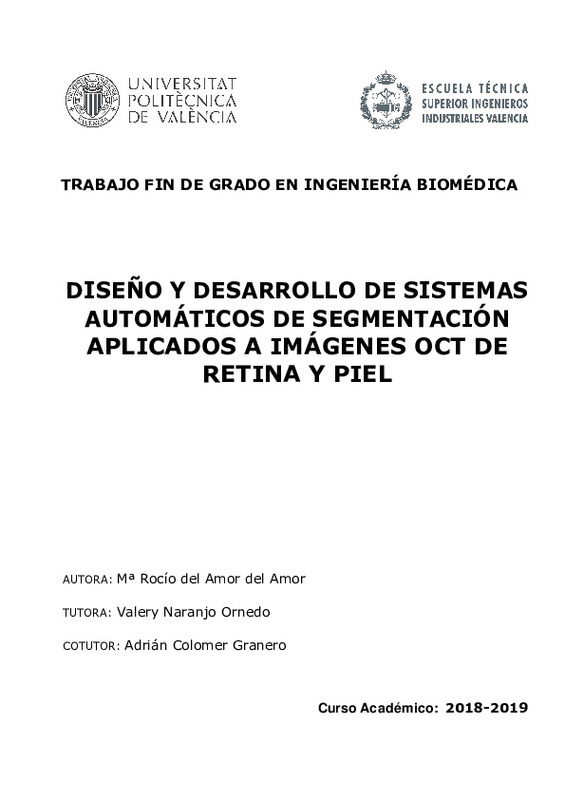|
Resumen:
|
[ES] La tomografía por coherencia óptica (OCT) es una técnica de diagnóstico por imagen basada en el principio de interferometría de baja coherencia con la que se obtienen cortes tomográficos a escala micrométrica. La OCT ...[+]
[ES] La tomografía por coherencia óptica (OCT) es una técnica de diagnóstico por imagen basada en el principio de interferometría de baja coherencia con la que se obtienen cortes tomográficos a escala micrométrica. La OCT es ampliamente utilizada como una modalidad de imagenología retiniana ya que es una técnica no invasiva capaz de capturar la estructura interior de la retina permitiendo monitorizar su posible daño. Una forma de monitorizarlo es a partir del análisis del espesor de las capas retinianas. Para obtener el grosor de las diferentes capas, es esencial realizar una segmentación previa. Por otro lado, actualmente, se está aumentando la aplicabilidad de la OCT a estudios dermatológicos. Un parámetro clave a inferir en estas imágenes es el espesor epidérmico. El análisis del grosor de esta capa permite realizar un diagnóstico temprano en algunas enfermedades como la psoriasis. Es por ello por lo que, la segmentación de las capas de la piel que permita delimitar la epidermis resulta fundamental. Sin embargo, la segmentación manual de imágenes tanto de retina como de piel por parte de los especialistas resulta tedioso y consume gran cantidad de tiempo. Por ello, es necesario el desarrollo de sistemas de segmentación automáticos que permitan reducir tanto la carga de trabajo como el nivel de subjetividad a la hora de realizar una segmentación manual.
El principal objetivo de este TFG reside en el desarrollo de algoritmos automáticos de segmentación basados en Deep learning con los que poder identificar tanto las diferentes capas retinianas como las principales capas de la piel. Para ello, se partirá de una base de datos de imágenes de piel y otra de retina que serán segmentadas manualmente con el objetivo de disponer del ground truth. Para llevar a cabo el algoritmo de segmentación se emplearán redes convoluciones autoencoders. Por otro lado, las imágenes OCT sufren de un tipo de ruido denominado speckle, que dificulta la extracción de características de la imagen. Debido a dicho fenómeno, se diseñarán diferentes algoritmos para la reducción automática de este tipo de ruido. Gracias a ello, se podrá comprobar como éste afecta a los resultados de la segmentación automática.
[-]
[EN] Optical coherence tomography (OCT) is a diagnostic imaging technique based on the principle of low coherence interferometry with which tomographic slices are obtained on a micrometric scale. OCT is widely used as a ...[+]
[EN] Optical coherence tomography (OCT) is a diagnostic imaging technique based on the principle of low coherence interferometry with which tomographic slices are obtained on a micrometric scale. OCT is widely used as a modality of retinal imaging since it is a non-invasive technique capable of capturing the inner structure of the retina allowing to monitor its possible damage. One way to monitor it is from the analysis of the thickness of the retinal layers. To obtain the thickness of the different layers, it is essential to perform a previous segmentation. On the other hand, currently, the applicability of OCT to dermatological studies is increasing. A key parameter to infer in these images is the epidermal thickness. The analysis of the thickness of this layer allows an early diagnosis in some diseases such as psoriasis. That is why the segmentation of the layers of the skin that allows delimiting the epidermis is essential. However, manual segmentation of both retina and skin images by specialists is tedious and time-consuming. Therefore, it is necessary to develop automatic segmentation systems that reduce both the workload and the level of subjectivity when performing a manual segmentation.
The main objective of this TFG is the development of automatic segmentation algorithms based on Deep Learning with which to identify both the different retinal layers and the main layers of the skin. To do this, It will be used a database of skin images and another one of the retina that will be segmented manually in order to have the ground truth. In order to carry out the segmentation algorithm, convolution networks autoencoders will be used.
[-]
|







